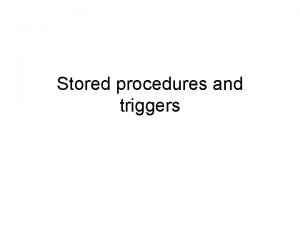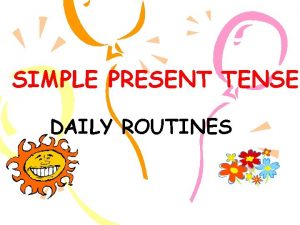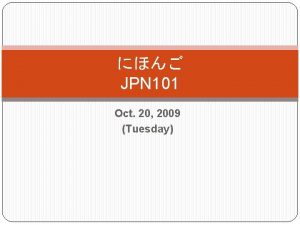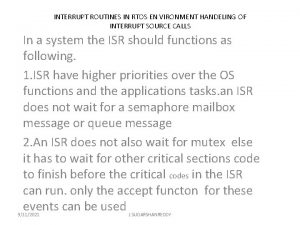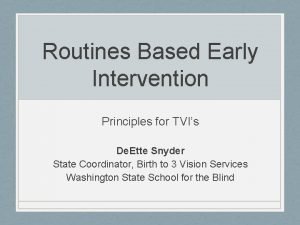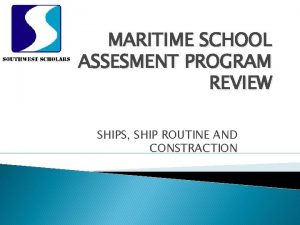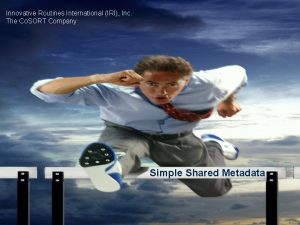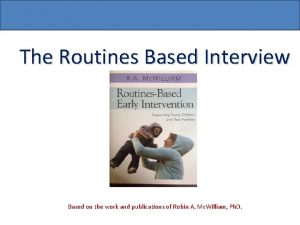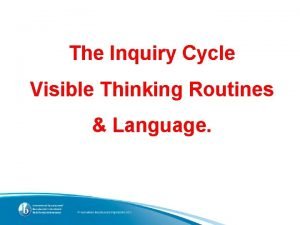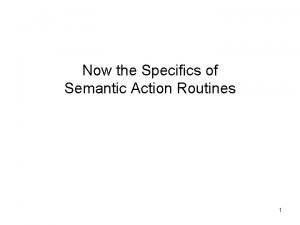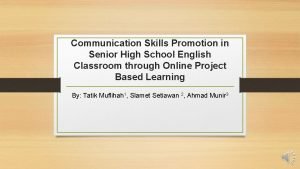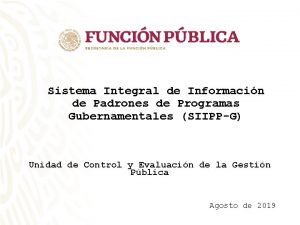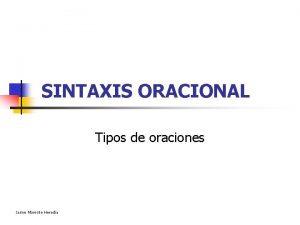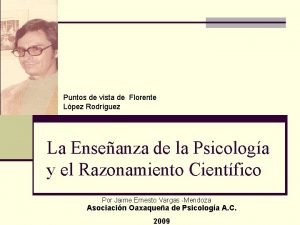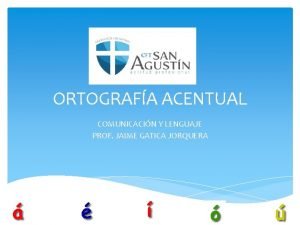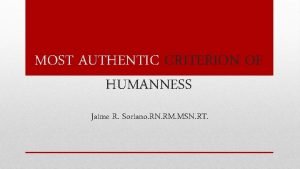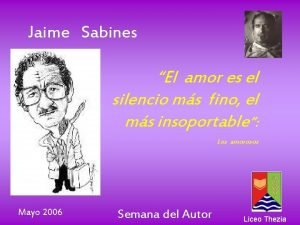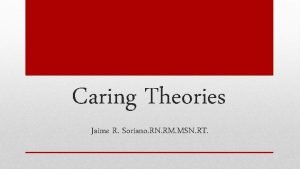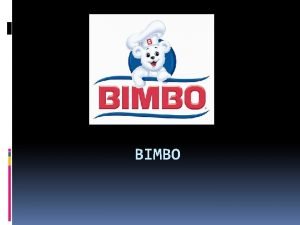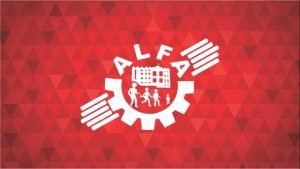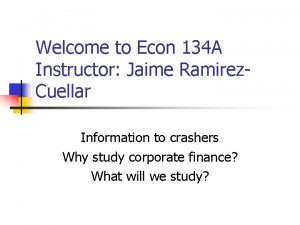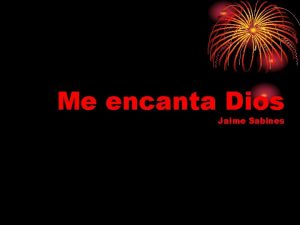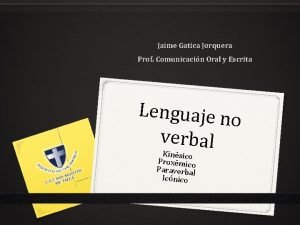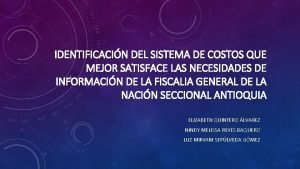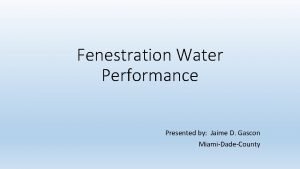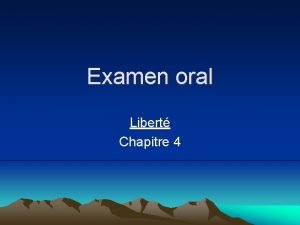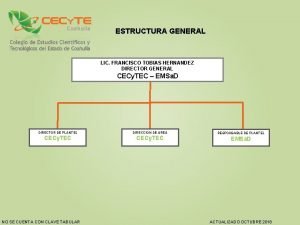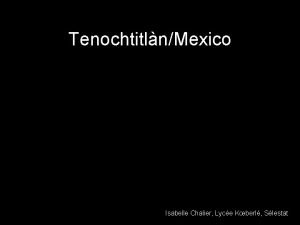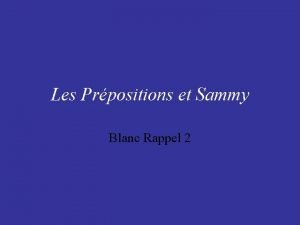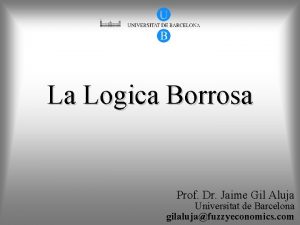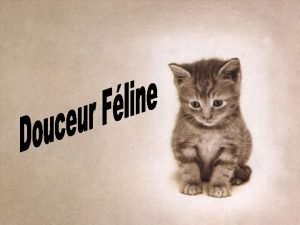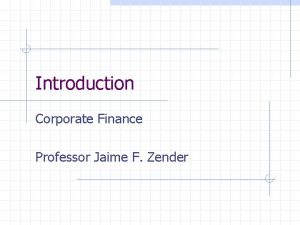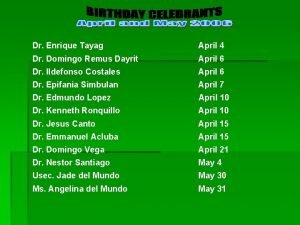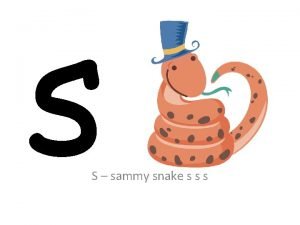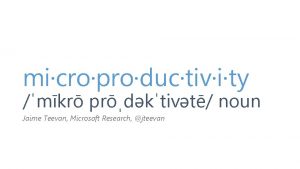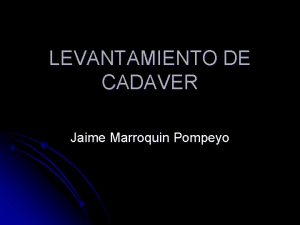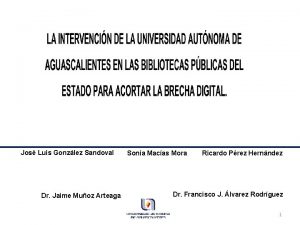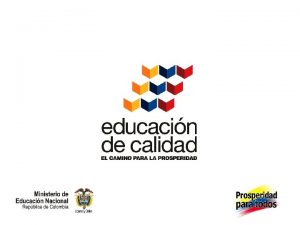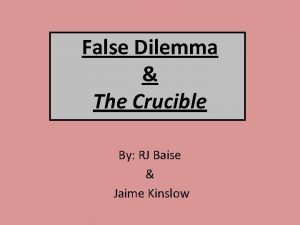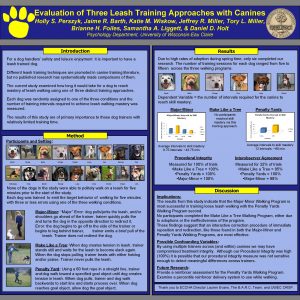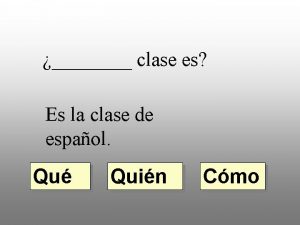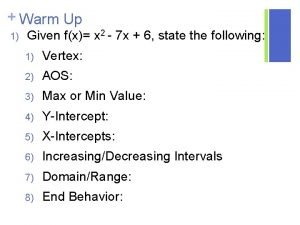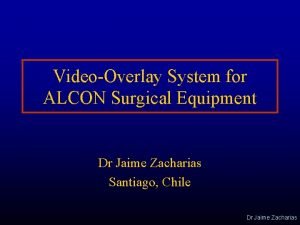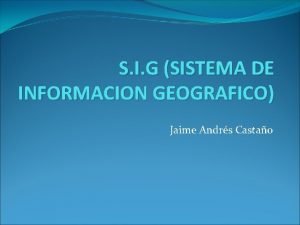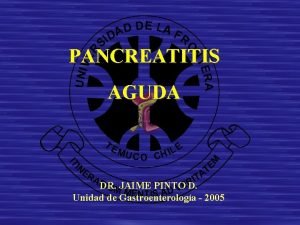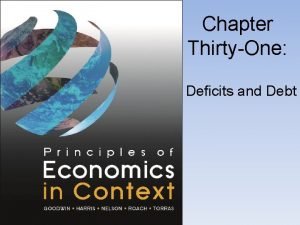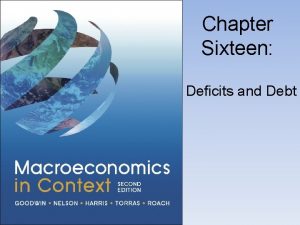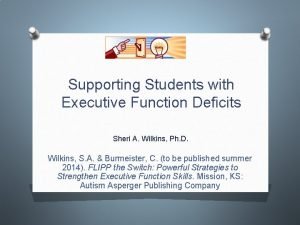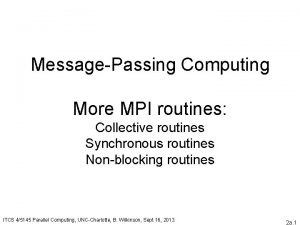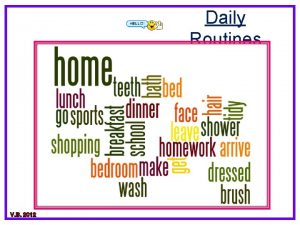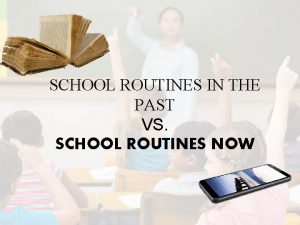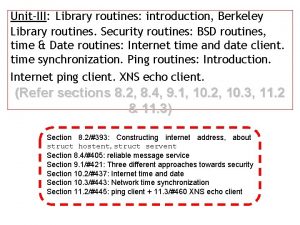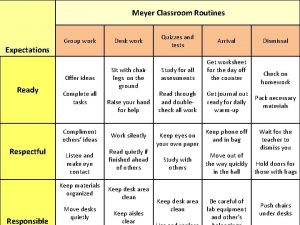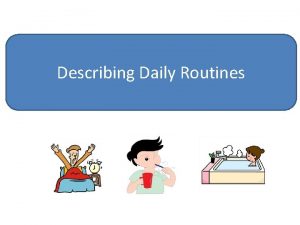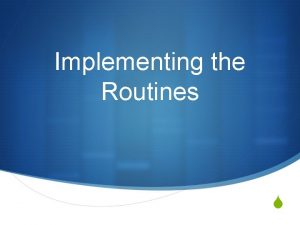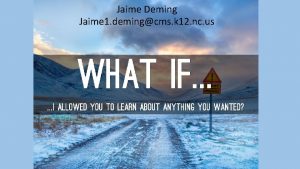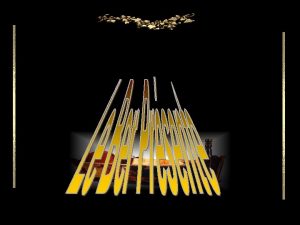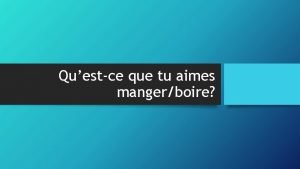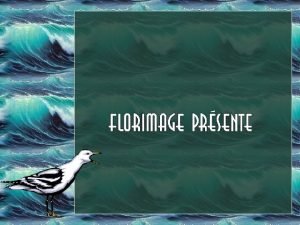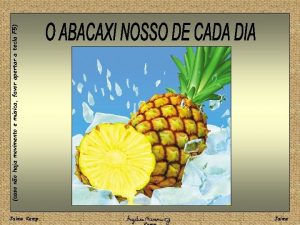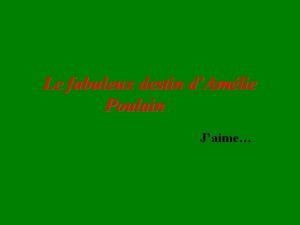Supporting Students with Communication Deficits Across Routines Jaime






















































- Slides: 54

+ Supporting Students with Communication Deficits Across Routines Jaime Lawson, M. S. CCC-SLP Meredith Laverdure, M. S. CCC-SLP Maggie Jarvela, M. S. OTR/L

+ Sharing Your Experiences What are your experiences with alternative and augmentative communication? n What is AAC? n “Augmentative and alternative communication (AAC) refers to using a form of communication to supplement or replace spoken and/or written words. AAC may include using signs/gestures, pictures, or an electronic device to help a person share his or thoughts” (Mc. Daniel, 2012).

+ n The Occupational Therapy Practice Framework states: n Why should OTs care about this? …because you’re nice people. And also… “Occupational therapy practitioners use their knowledge of the transactional relationship among the person, his or her engagement in valuable occupations, and the context to design occupation-based intervention plans that facilitate change or growth in client factors… and skills (motor, process, and social interaction) needed for successful participation. Occupational therapy practitioners are concerned with the end result of participation and thus enable engagement through adaptations and modifications to the environment or objects within the environment when needed. ” (AOTA, 2014).

+ AAC and Engagement “A word devoid of thought is a dead thing, and a thought unembodied in words remains a shadow. ” Lev S. Vygotsky “Not having heard something is not as good as having heard it; having heard something is not as good as having seen it; having seen it is not as good as knowing it; knowing it is not as good as putting it into practice. ” Xunzi

+ What is Language? n Language is made up of socially shared rules that include the following: n n What words mean How to make new words How to put words together What word combinations are best in what situations (ASHA, 2016 b) n “Language is the system that allows us to understand produce speech and writing. ” n “Vocabulary is only one element of language. ” n “Language is how vocabulary fits together to create meaning and communication” (Baker, Witkowski, Navrotski, & Kovach, 2015).

+ Core and Fringe Vocabulary n Core vocabulary n n n Small, commonly used vocabularies Does not change across environments or between users Core shows a 90% overlap from preschool through adulthood and does not vary demographically with any language (Baker, Witkowski, Navrotski, & Kovach, 2015) A child can communicate a variety of topics across multiple settings using a set of core vocabulary (Nevers, 2010) Fringe vocabulary n n n Based on individual preferences Changes with environments and activities (Banajee, 2015) Lacks varied parts of speech with heavy use of nouns (Nevers, 2010)

+ Core and Fringe Vocabulary (Nevers, 2010) Characteristic Core Vocabulary Fringe Vocabulary Number of Words Small number of words Very large number of words Frequency of Use High frequency Low frequency, occur infrequently Applicability Across Environments Applicable to all environments Applicable to limited environments, lack versatility Applicability Across Topics Applicable to all topics Applicable to limited topics Types of Words Includes a variety of parts of speech Includes mostly proper names and other nouns Usefulness in a Single Message Approximately 80% of the words in a 100 -word sample will be core, but many core words will be used repeatedly, so the number of different words is small. Approximately 20% of the words in a 100 -word sample will be fringe. Number of different words will be large, as fringe words are repeated with much lower frequency than core words.

+ Core and Fringe Vocabulary n Limitations of fringe

+ Core and Fringe Vocabulary – You Decide! Eat Help Bathroom Name Toaster Yes My What Frisbee Game Go Open Cup Spoon Up School Mom Milk Sit That Seat Some

+ Vocabulary Research n Banajee, Di. Carlo, & Stricklin, 2003 n Researchers studied the vocabulary of 50 toddlers between the ages of 2 -3 years old. n 26 core words made up 96. 3% of everything the toddlers said/produced.

+ Which of these words have you seen on a communication board/system? Which word are you surprised to see?

+ Vocabulary Research n Marvin, Beukelman, & Bilyeu, 1994 n Surveyed the language of 10 nondisabled preschoolers at home and at preschool n Detected similar vocabulary-use patterns at home and at preschool



+ Vocabulary Research n Balandin & Iacono, 1999 n Surveyed the language of 34 non-disabled adults n 347 core words made up 78% of the language sample



+ Our Example n https: //youtu. be/6 J 1 Mqr. Q 8 uxg

+ Our Example Word Freq. I 14 Of 2 Sadie 1 And 10 See 2 Have 1 This 10 Rainbow 2 A 1 The 9 Watermelon 2 Food 1 Colored 7 Fighting 2 Fight 1 That 4 Here 2 Want 1 Not 4 Over 2 Tell 1 These 3 Hamburger 2 You 1 Did 3 Know 2 Made 1 Um 3 Hi 1 Let 1 Color 3 My 1 Me 1 One 3 Name 1 Three 1 To 2 Is 1 Four 1

+ Our Example Word Freq. They 1 Ice cream 1 Are 1 Do 1 Those 1 Who 1 Cat 1 But 1 Candles 1 Bottom 1 Windows 1 Almost 1 About 1 Fall 1 Off 1 Well 1 Legs 1 Donuts 1

+ Our Example

+ Your Turn n Name common routines frequently addressed during therapy sessions. n As a group, brainstorm core vocabulary that is appropriate for a child’s communication system for these routines.

+ The Spectrum of Communication Systems Visual Supports No-tech systems Low/midtech systems Hightech systems

+ Things to Consider (Nevers, 2010) Format Line drawings, photographs, text, etc. Symbols Access Vocabulary, messages, organization, layout, etc. Device, book, board, pictures, signs, etc. Content Point, switch, eye gaze, etc.

+ Visual Supports n An aid to facilitate a desired action or behavior during an activity n Benefits n A visual representation of a desired outcome n Decreasing the amount of verbal bombardment and increasing input of expectations n Multimodality input for an activity

+ Visual Support – Incorporating Core Vocabulary n Use the picture to demonstrate the target action or specific task while using the written direction to provide core vocabulary exposure n Repetitive use of core vocabulary in the directions will allow for increased acquisition of the target vocabulary across multiple tasks. It does not result in the simplification of the task.

+ Visual Supports - Examples n First, then board n Choice boards

+ Visual Supports - Examples n Sequencing strip n Transition visuals

+ Visual Supports - Examples n Visual Schedule (Van Tatenhove, N. D. )

+ Visual Supports - Examples

+ No/Lite-Tech Communication Systems n A static communication system that teaches preliminary communication skills, such as cause and effect as it applies to communication. n Paper-based systems (Grandbois, 2012) n Emphasizes the exchange of information from one person to another (Grandbois, 2012) n Benefits n n n Decreases the expectations given to the user to manage a dynamic display Allows for tactile manipulation of targeted responses, such as putting together a sentence strip Provides a consistent visual prompt of targeted responses with decreased requirement of verbal bombardment/prompting

+ No-Tech Communication Systems – Incorporating Core Vocabulary n Utterances are generated using applicable core vocabulary through a system that can be used across activities. n Due to ease of manipulation, it can be used across activities and settings easily, increasing opportunities to learn and produce core vocabulary in various activities. n Within each activity, associated fringe may be presented. n Again - repetitive use of core vocabulary in the directions will allow for increased acquisition of the target vocabulary across multiple tasks.

+ No-Tech Communication Systems Examples n Sentence strip n Core communication boards

+ No-Tech Communication Systems Examples n PASS software with Unity

+ No-Tech Communication Systems Examples n In the classroom

+ Low/Mid-Tech Communication Systems n Portable, inexpensive, voice output communication system typically with a static display (Grandbois, 2012) n n It may require caregiver/educator involvement to change overlays or voice output settings. Benefits n n n n Can be used with a no-tech communication system to pair core and fringe vocabulary across settings Exposes the user to voice output and expanded field sizes Can create opportunities for repairing communication breakdowns Cost efficient and more availability within the school system Multiple access options Provides tactile feedback upon access, giving the user increased awareness of access Varying field sizes depending on which system is introduced, starting a field of one, going up to field sizes of 32 Scanning capabilities

+ Low/Mid-Tech Communication Systems – Incorporating Core Vocabulary n Static overlays can be used to prioritize core vocabulary use, teaching the user its application across activities. n Allows for vocabulary to remain in the same location, which improves motor planning and automaticity

+ Low/Mid-Tech Communication Systems - Examples n Minicom and Sequencer Switch n Rocking Switch n Cheap Talk 4 and 8

+ Low/Mid-Tech Communication Systems - Examples n Big Mack and Little Mack n Quick Talker n Go-Talk 9, 16, and 20

+ Low/Mid-Tech Communication Systems - Examples n 32 Communicator

+ High-Tech Communication Systems n Speech generating devices, typically with dynamic display, meaning the user can change the vocabulary screen by pressing a button (Grandbois, 2012) n n Most often dedicated systems, meaning that the device is for communication only Benefits n n n Access to larger field sizes with minimal caregiver/educator involvement Capabilities to modify field sizes with ease depending on various user factors, such as vision, motor access, and communication needs Scanning capabilities Variety of access modifications Vendor representative and tech support resources

+ High-Tech Communication Systems – Incorporating Core Vocabulary n Home/Core page is programmed with high frequency core words to produce a variety of utterances with limited navigation n Fringe vocabulary is linked to its associated core word n n For example, foods are linked to ‘eat’ Allows for vocabulary growth and language expansion over time by hiding and showing vocabulary as deemed appropriate n Decreasing opportunities of feeling overwhelmed by having all of the core vocabulary shown at one time initially

+ High-Tech Communication Systems - Examples n n Tobii/Dyna. Vox n I-12 and I-15 n T 7, T 10, T 15 Prentke Romich Company n n Accent 800, 1000, and 1400 Saltillo n Nova Chat 5, 8, 10, 12

+ High-Tech Communication Systems - Examples n n Talk to Me Technologies n Wego 10 A, 7 A, 10 W n eyepeak n Zuvo i. Pad n Proloquo 2 go n Verbally n Sono Flex

+ Descriptive Answers n Emphasizes the use of core vocabulary (Baker, Witkowski, Navrotski, & Kovach, 2015). n n n Users provide a definition or description of a word using core vocabulary Teaches students to use permanent words in flexible and meaningful ways Talk “about, ” “how, ” “where, ” etc. (Nevers, 2010) n Not “what” n Targets longer sequences of symbols (Nevers, 2010) n Prioritizing the use of high frequency vocabulary virtually eliminates the need to program a revolving vocabulary of curriculum words (Baker, Witkowski, Navrotski, & Kovach, 2015). n Benefits (Baker, Witkowski, Navrotski, & Kovach, 2015). n n Students are given opportunities throughout the day to learn language skills Students receive ongoing practice in using high frequency vocabulary in a variety of contexts

+ Descriptive Answers n For example – n Ocean: biggest water n Teepee: where they live n Hunting: way to get food n YOUR TURN!

+ Applying Core Vocabulary n As a group, select 3 daily routines across 3 different age demographics. n 1. Playdough n 2. n 3. n From the set overlay, select 8 core vocabulary words and write in 8 fringe vocabulary words that are suitable for all 3 activities. n Demonstration

+ Motor Automaticity n Related to the development of motor patterns associated with specific symbols n Makes communication effective and efficient n n n Automaticity is possible with (Adkins, 2012): n n Habitual movements become subcortical Cortical areas can be put to better use (Adkins, 2012) Consistent icon location A small icon set (immediate recognition) Predictable transition from one icon to the next Automaticity is not possible when (Adkins, 2012): n n Significant navigation is required An AAC user must continually refocus and reorient to the communication system n Requires a consistent layout and symbols that don’t move (Nevers, 2010)

+ Motor Automaticity n “Normally speakers have no conscious access to language encoding or articulation. For most speakers, language production is relatively effortless. ” (Schlosser, 2003 as cited by Adkins, 2012) n Motor Learning Stages (Adkins, 2012) n n n Cognitive stage n Learner must attend to the process of learning a motor action n Highly variable performance n Needs guidance to detect and correct errors Associative stage n Refining skills n Able to detect and correct errors Autonomous stage n Result of much practice n Not concentrating on the movement and can attend to other aspects of the activity

+ Motor Automaticity (Baker, Witkowski, Navrotski, & Kovach, 2015). n Cognitive component: Awareness of general situation, identification of icon and position in sequence, knowledge of its location n Physical component: Knowing how to access an icon, having a motor plan for a particular icon sequence n Linguistic component: Knowledge of existence of a link between an icon and word, knowledge of the semantic role of the word

+ Conclusion n Core vocabulary is applicable to all communicators, all situations, and all communication functions. n “True communication is spontaneous and novel… Communication requires access to a vocabulary of individual words suitable to our needs that are multiple and subject to change” (ASHA, 2016 a). n n The best opportunity to target true language development is when a child is fully engaged and motivated. Questions?

+ Contact Us n Jaime Lawson – Jaime. Lawson@chkd. org n Meredith Laverdure – Meredith. Laverdure@chkd. org n Maggie Jarvela – Meaghan. Jarvela@chkd. org

+ References n Adkins, J. (2012, June). Language acquisition through motor planning. The Center for AAC and Autism. Retrieved from http: //doepartnership. fmhi. usf. edu/archive/Sum. Inst_2012/Handouts 2012/Adkins_LAMP_Color. pdf n American Occupational Therapy Association (AOTA). (2014). Occupational therapy practice framework: Domain and process (3 rd ed. ). American Journal of Occupational Therapy, 68 (Suppl. 1), S 1 -S 48. n American Speech-Language-Hearing Association (ASHA). (2016 a). Augmentative communication: A glossary. Retrieved from http: //www. asha. org/public/speech/disorders/AAC-Glossary/ n American Speech-Language-Hearing Association (ASHA). (2016 b). What is language? What is speech? Retrieved from http: //www. asha. org/public/speech/development/language_speech/ n Baker, B. , Witkowski, D. , Navrotski, D. , & Kovach, T. (2015, December). Picturing language: A “how-to” workshop. Paper presented at Pittsburgh AAC Language Seminar, Pittsburgh, Pennsylvania. n Balandin, S. & Iacono, T. (1999). Crews, wusses, and whoppas: Core and fringe vocabularies of Australian meal-break conversations in the workplace. Augmentative and Alternative Communication, 15, 95 -109. n Banajee, M. (2015, December). Vocabulary selection. Paper presented at Pittsburgh AAC Language Seminar, Pittsburgh, Pennsylvania.

+ References n Banajee, M. , Dicarlo, C. , & Stricklin, S. B. (2003). Core vocabulary determination for toddlers. Augmentative and Alternative Communication, 19, 67 -73. n Grandbois, K. (2012, November). Augmentative and alternative communication. Autism Speaks. Retrieved from https: //www. autismspeaks. org/sites/default/files/augmentative_alternative_communication _webinar. pdf n Marvin, C. A. , Beukelman, D. R. , & Bilyeu, D. (1994). Vocabulary-use patterns in preschool children: Effects of context and time sampling. Augmentative and Alternative Communication, 10, 224 -236. n Mc. Daniel, J. (2012). No-tech and low-tech AAC for children with autism spectrum disorders (ASD): A guide for parents. Vanderbilt Kennedy Center. Retrieved from http: //kc. vanderbilt. edu/kennedy_files/AACChildrenwith. ASD-April 12. pdf n Nevers, M. (2010, December). Getting started with core vocabulary. Retrieved fromhttp: //www. uvm. edu/~cdci/at/webinars/core_vocab_12 -152010/files/core_vocab_full_page_slides. pdf n Van Tatenhove, G. (N. D. ) Using visual schedules to expose and reinforce core vocabulary. Retrieved from http: //www. minspeak. com/teachers/documents/Visual%20 Schedules%20 Core-Pixons. pdf
 Triggers and routines in sql
Triggers and routines in sql Daily routines simple present tense
Daily routines simple present tense Daily routines and adverbs of frequency
Daily routines and adverbs of frequency Interrupt routines in rtos
Interrupt routines in rtos Family guided routines based intervention
Family guided routines based intervention Flounder plate ship
Flounder plate ship Innovative routines international
Innovative routines international Routines based interview
Routines based interview Pyp visible thinking routines
Pyp visible thinking routines Semantic routines
Semantic routines Miguel morayta rizal
Miguel morayta rizal Communication skills of senior high school students
Communication skills of senior high school students Jaime arturo larrazábal escárraga
Jaime arturo larrazábal escárraga Verbo subordinado
Verbo subordinado Jaime florente
Jaime florente Quisieron lleva tilde
Quisieron lleva tilde Sister simone roach
Sister simone roach Dr jaime schehr
Dr jaime schehr Jaime sabines el amor es el silencio
Jaime sabines el amor es el silencio Dr jaime soriano
Dr jaime soriano Jaime sendra grimau
Jaime sendra grimau Que porcentaje de 480 es 24
Que porcentaje de 480 es 24 Jaime ramirez cuellar
Jaime ramirez cuellar A mi me encanta dios jaime sabines
A mi me encanta dios jaime sabines Jhon jaime osorio
Jhon jaime osorio Gesto patografo
Gesto patografo Carlos jaime taborda tamayo
Carlos jaime taborda tamayo Jaime gascon
Jaime gascon Examen prononciation
Examen prononciation Jaime rmz jasso
Jaime rmz jasso Jaime frade
Jaime frade El encuentro jaime zapata
El encuentro jaime zapata Jaime ledezma
Jaime ledezma Sammy jaime pack
Sammy jaime pack Jaime gil aluja
Jaime gil aluja Jaime les chat
Jaime les chat Jaime zender
Jaime zender Jamie markham
Jamie markham Dr jaime dy liacco
Dr jaime dy liacco Jaime puente
Jaime puente Sammy jaime xxx
Sammy jaime xxx Text recognition image
Text recognition image Ricardo gorocica romero
Ricardo gorocica romero Dr jaime luis gonzalez
Dr jaime luis gonzalez Jaime villamarin
Jaime villamarin Moral dilemmas in the crucible
Moral dilemmas in the crucible Jaime perszyk
Jaime perszyk Tú ____ en la clase de jaime, ¿verdad?
Tú ____ en la clase de jaime, ¿verdad? Dr. jaime cepeda
Dr. jaime cepeda Jaime owns a business making decorative boxes
Jaime owns a business making decorative boxes Jaime zacharias
Jaime zacharias Jaime andres castaño actor
Jaime andres castaño actor Dr jamie pinto
Dr jamie pinto Jaime salvatore
Jaime salvatore Infancia y confesiones
Infancia y confesiones
